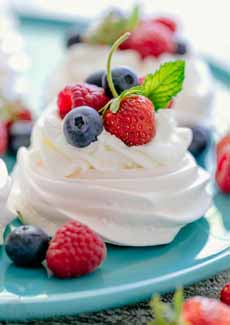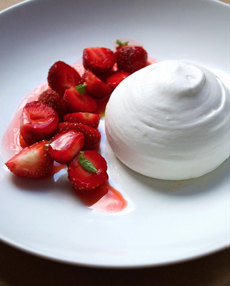TIP OF THE DAY: Pavlova Dessert For Passover & Easter
|
If you’ve ever seen individual meringue cups/shells in a bakery and wondered what they are: They’re the base of Pavlovas*. Light and airy, they are filled with fruit to make an impressive gluten-free and fat-free dessert (photo #2). Pavlova is quick-assembly dessert that’s impressive and low-calorie. It consists of a meringue base topped with fresh fruits. Most people buy the meringue shells at bakeries, but ambitious bakers can make their own. In addition to individual meringue shells (“mini pavlovas”), the meringue is often shaped into a layers (photo #1). If you see meringue shaped into cake-like layers with fillings in-between, that’s a Swedish Midsummer Meringue Layer Cake. In France, the meringue layers can be filled with crème fraîche, custard, fruit, mousse, whipped cream or other filling, and is called a vacherin (vosh-er-RAN). Pavlova is gluten-free, fat-free, a beauty for the Easter table and Passover-friendly: The ingredients are egg whites, sugar, cornstarch, lemon juice and vanilla extract. You can also add subtle flavor touches. This Pavlova, from chef Samir Nosrat, has touches of Indian flavors: rosewater, rose petals and cardamom. While it seems a light and airy dessert for warmer weather, Pavlova is a year-round treat. It’s a good finale to a big dinner. And it can be tailored to every season: You can make individual meringue cups or one large meringue base. Once you have the meringue shells: Pavlova is one of the most popular desserts in Australia, where it’s commonly known as Pav, for short. The dessert is named after the legendary Russian ballerina Anna Pavlova, who toured Australia and New Zealand in 1926 and 1929. Both countries claim to have invented this dessert, and have made it their national dessert. New Zealand may have the edge: Published recipes of fruit-filled meringue shells existed there without the name Pavlova. According to chef Herbert Sachse of the Hotel Esplanade in Perth, Australia, the Pavlova was born at the hotel 1935. According to hotel legend†, it was named at a meeting at which Sachse presented the cake. |
|
|
|
Either the hotel licensee, the manager or Sachse remarked, “It is as light as Pavlova,” who had been a guest of the hotel during her 1929 tour. Years later, Sachse stated in an interview that he sought to improve the Meringue Cake recipe that he found in the Women’s Mirror Magazine, which was contributed by a New Zealand resident.* *Pavlovas are filled with fruit, but the shells can be filled with other ingredients, for example, custard, mousse or whipped cream. †Source: Linda Stradley, What’s Cooking America.
|
||






